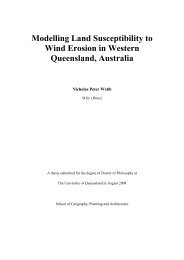Final Report: Strengthening Community Research in ... - Ninti One
Final Report: Strengthening Community Research in ... - Ninti One
Final Report: Strengthening Community Research in ... - Ninti One
Create successful ePaper yourself
Turn your PDF publications into a flip-book with our unique Google optimized e-Paper software.
What ‘gaps’ <strong>in</strong> knowledge are there?What k<strong>in</strong>d of research method would be best to achieve the outcome required?2. Plan, prepare Craft the research question/s Design the participant <strong>in</strong>formation about who commissioned the research, who is undertak<strong>in</strong>g it, whothe researchers are. Draft Informed Consent to <strong>in</strong>clude the ethical and privacy statement, permission to record audio ortake photos and a no-obligation statement for participants’ choice to be <strong>in</strong>volved. Prepare the work plan for apply<strong>in</strong>g the research <strong>in</strong>strument: who will do what, where, when, how?3. Do itAdm<strong>in</strong>ister the <strong>in</strong>formed consent and research <strong>in</strong>strument to participantsMonitor the process so that it rema<strong>in</strong>s exactly the same with each application of the <strong>in</strong>strumentKeep tally of demography and other important goalsRegularly discuss <strong>in</strong> the team how it’s go<strong>in</strong>g, what it’s like, what’s work<strong>in</strong>g well, what’s hard, etc.4. Review, reflect Collate the research data Extract the trends and f<strong>in</strong>d<strong>in</strong>gs Make some analysis of what the research <strong>in</strong>dicates <strong>Report</strong> the f<strong>in</strong>d<strong>in</strong>gs back to Wurla Ny<strong>in</strong>ta Critically review the process, language, questions, and other operational aspects to extract learn<strong>in</strong>gand best practice guidel<strong>in</strong>es for the next cycle.4.3.3 <strong>Research</strong> <strong>in</strong>strumentThe decision to use a survey <strong>in</strong>strument emerged from look<strong>in</strong>g at various examples of research that <strong>in</strong>volved hownumerical data can tell a research story.Because there are many survey <strong>in</strong>struments applied to Aborig<strong>in</strong>al communities, this was also an opportunity to engagedifferently with the experience of be<strong>in</strong>g a respondent.Most importantly, it provided an opportunity to reth<strong>in</strong>k how a survey could be phrased so that people with English as asecond language could better understand it. Then the researchers used their multil<strong>in</strong>gual skills and translated thequestions from simple English <strong>in</strong>to Arrarnta.The f<strong>in</strong>al survey <strong>in</strong>strument evolved from several workshops, practices and re-writes. The <strong>in</strong>strument was applied to ademographic that represented 20% of the target age range of 18–60 year olds, based on Census data from 2006.Ntaria Driv<strong>in</strong>g Survey: age groupsTarget to surveyAge(=20% of Ntaria population as atCensus 2006)Actual numberssurveyedVariance18–25 28 29 126–30 17 15 -231–35 16 18 236–45 22 23 146–60 20 18 -2Total 103 10334 <strong>F<strong>in</strong>al</strong> <strong>Report</strong>: <strong>Strengthen<strong>in</strong>g</strong> <strong>Community</strong> <strong>Research</strong> <strong>in</strong> Remote Service Delivery at Ntaria
















